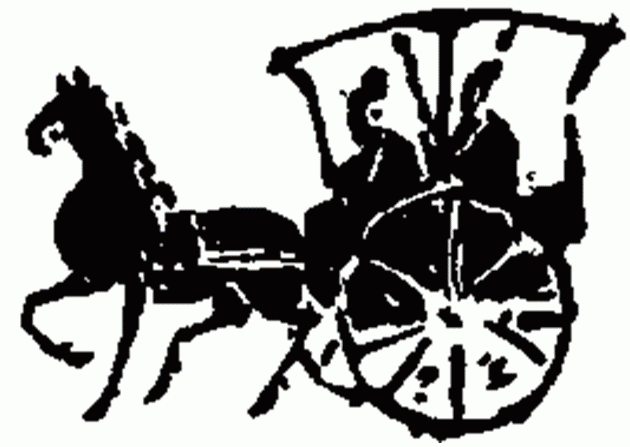
Elegantly Digitized Rubbing of Ancient Chinese Vehicle
(The view looking down from above is immortalized in the character 車 chē, which means “vehicle.”)
| Go to
web site main page, learning resources index. |
Content Created: 2017-05-17. File last modified: |
1. In Chinese (nearly) every syllable is meaningful, even though a “word” can sometimes be a compound of several syllables:
huǒ (fire) + chē (vehicle) = huǒchē (locomotive).
2. In all dialects of Chinese throughout history, there have been limits on how complex a spoken syllable could be. For example in standard, modern Mandarin a syllable consists of: (initial consonant) + (vowel 1) + vowel 2 + (n or ng). (Items in parentheses are optional.) Further, each syllable is pronounced with one of four distinctive pitch patterns (tones), shown in Romanized spellings by distinctive accent marks: nián tǎn bǔ ā xiàn xiān are syllables in modern Mandarin. Pwat fas tril def skarp are not.
Standard modern Mandarin has 21 initial consonants, 37 “syllable finals” (vowels, diphthongs, or combinations of a vowel and final consonant), and 4 tones, to produce a theoretical total of 21 x 37 x 4 = 3108 possible syllables, although many theoretically possible syllables do not in fact occur.
3. Since there are so few syllable types, most spoken syllables have more than one field of meaning. For example:
biān = edge; whip; compile; bat; to pierce with a stone probe
fú = prop up; prisoner; fall; not; thus; bat; happiness; float
4. Chinese written characters represent syllables, but for each different “meaning” of a spoken syllable, there is a different written character (logograph):
biān = edge 邊; whip 鞭; compile 編; bat 蝙; or to pierce with a stone probe 砭.
fú = prop up 扶; prisoner 俘; fall 伏; not 弗; thus 夫; bat 蝠; happiness 福; or float 浮
5. Spoken language depends upon context to tell which “meaning” of a syllable is intended. Often, two-syllable “synonym compounds” help create this context and resolve the ambiguity:
biān-fú = bat (the only meaning shared by both biān and fú)

Note that in the written language either biān 蝙 or fú 蝠 can theoretically mean “bat,” so the compound 蝙蝠 corresponding to the spoken biānfú is technically redundant. In modern written Chinese this redundancy is tolerated. In Classical Chinese one written syllable alone was all that was normally considered necessary, and indeed excess redundancy was considered rather vulgar. Partly for this reason, in Classical Chinese, writing did not perfectly echo the spoken language, despite the capacity to do so, and well drafted Classical Chinese texts were quite abbreviated by the standards of modern usage.
6. Where do the logographs come from? Some Chinese characters directly represent concepts. (For example, the character for “big,” pronounced dà, represents a person with his arms spread: 大.) But most characters are compounds of (1) a meaningful “radical” and (2) a “phonetic” commonly associated with approximately the sound of the syllable. Thus in biān 蝙 and fú 蝠 (the two characters referring to bats) the 虫 part shared by both is a radical meaning “bug or small animal.” It works essentially the same way an ancient Egyptian determinative does. The 扁and 畐 are phonetics. Anything with a 扁 in in is likely to be pronounced biān or piān (or biăn or piăn); anything with a 畐 (or a 夫) in it is likely to be pronounced fū or fú.
There are conventionally considered to be 214 “radicals” and 888 “phonetics,” generating, in theory, 214 x 888 = 190,032 compound characters (plus the 214 radicals used in isolation and some composed in other ways). Today’s official “simplified” character set is slightly different, but the differences are minor. The largest Chinese dictionary lists 49,905 characters, leaving the hundred and forty thousand or so remaining permutations yet to be invented. It is said that the average person probably needs knowledge of something over 3,000 characters to be marginally literate. (In dynastic times some people apparently got on fine by learning only a handful of characters useful for their particular jobs, so “marginally literacy” turns out to be a more complicated idea than it appears to be.)
The Chinese Board of Standards approved a list of 6,763 for use in computerized word processing, but most writers feel that a computer type font with fewer than about 10,000 characters definitely cramps one’s style, so it is not clear that the 3,000 characters needed by one marginally literate person are the same 3,000 needed by another. Version 2 (1997) of the international Unicode standard, filled hexadecimal addresses 4E00 to 9FFF with a “Chinese-Japanese-Korean unified character set,” thus setting a standard for the near future of 20,991 characters for use in the world's computers. By Version 3 (published in 2000) an additional seven thousand were added. By Version 4 (2003) 70,207 characters were included, most still not actually available in most computer type fonts. And the number has continued to creep upward.
What These Examples Show. Both Egyptian and Chinese are popularly misunderstood. Both have a huge number of signs and both work differently from Western languages. Neither is alphabetic, despite the presence of an alphabet as one part of the Egyptian system. But both are nevertheless linked intimately to the sounds of the spoken language, and this is why both are able to function as full writing systems, in which it is possible to write grocery lists, love letters, or college exams.
Return to top.
Go to next page.